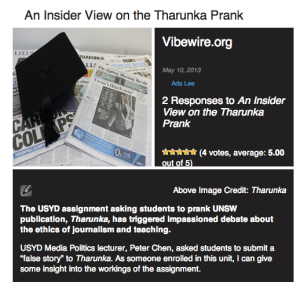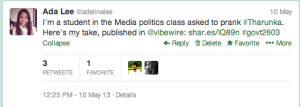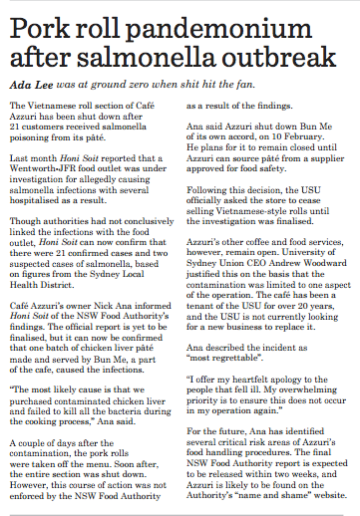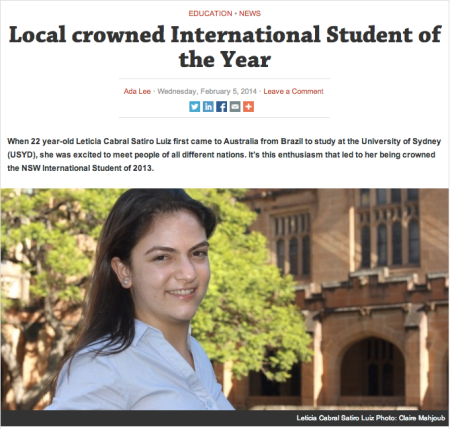

The USYD assignment asking students to prank UNSW publication, Tharunka, has triggered impassioned debate about the ethics of journalism and teaching.
USYD Media Politics lecturer, Peter Chen, asked students to submit a “false story” to Tharunka. As someone enrolled in this unit, I can give some insight into the workings of the assignment.
Essentially, students were to figure out what makes stories publishable. To complete the assignment, we had to test our hypothesis on ‘what makes the news’ by constructing several false articles that covered a scope of topics with varying levels of quality and sensationalism. In doing so, we tested the role of media as gatekeepers of information and whether they were susceptible to ‘spin’ and manipulation. The assignment sheet said we were to “reflect on the practice of PR that uses an understanding of media practice to promote particular messages”.

GOVT2603 Unit of Study Outline
On 6 May, Tharunka discovered the truth via a whisteblowing student and on 8 May, Tharunka revealed all in an article by editor Lily Ray. Editors recalled their surprise at the sudden influx of student submissions—even those from USYD email addresses.
Lily Ray even wrote that Tharunka was happy to receive submissions from students of other universities. The point of concern, however, seemed to rest in the assignment requirement that students post falsestories.
The whisteblower from the GOVT2603 subject, Josh Tassell, told Crikey,“I have a major ethical problem with trying to print lies. I don’t see the point. I honestly don’t think it taught us much at all except terrible habits.”
The same day that Tharunka, Crikey and The Australian picked up the story, the GOVT2603 twitter and tumblr accounts were deleted.
Over the semester, Dr Chen has become a familiar face—particularly notable for his Mohawk which changes colour every week. He asks students to engage via twitter, tumblr and text messages. At times, he spoke about his involvement in the NTEU Sydney University strikes. In lectures, he got us to watch a documentary critiquing Fox News sensationalism and another that explored election campaign tactics in New Zealand.
When we got the assignment sheet, I noticed mixed reactions. There were five different topic options. Others included creating an online protest page for a “fictitious” cause or trying to get calls through on talkback radio. We were told in our tute that all five topics had to be covered. In response to the Tharunka exercise, some students thought it was hilarious, some a useful exercise and perhaps, others worried about the ethical boundaries it pushed.
Whether the assignment was successful in teaching any sort of lesson, I think it is fair to say Dr Chen did not intend to teach his students how to be lying spin-doctors. Rather, the lesson was more in exploring the potentially powerful role ‘spin’ can play in today’s media system. Here, it is important to note that this is a ‘Media Politics’ not a journalism unit.
Granted, if this was the purpose of the assignment, Tharunka editor, Renee Griffiths, makes the point in the Crikey comments section:
“wouldn’t it have been more fruitful to make students target the multitude of organisations that are better resourced and deal more extensively with said PR injecting?” On Twitter, editor Lily Ray said the assignment “victimized” Tharunka.

Image Credit: Tharunka
James Davey, another GOVT2603 student, disagrees.
“I don’t understand why [Tharunka is] making the ‘victim’ call on this one…I don’t think it was a targeted attack against Tharunka…[The assignment’s lesson] could be learned through any news organisation. It just happened to be Tharunka.”
The ensuing upheaval has been met with a variety of responses from Media Politics students. Some worry about the academic ramifications. Some believe Mr Tassell over-reacted whilst others thought he could have handled the situation better.
Mr Davey defended the assignment. He said:
“It is up to the editor of a news organisation to vet any and all submissions. The fact is that Tharunka found itself with articles it was willing to run. When someone informed them of the ‘prank’, they got embarrassed. Cue retaliatory article. The reality of the news landscape is that it is competitive. It was on point and a relevant assignment.”
In July last year, UNSW SRC students actually launched a similar prank. A UNSW Foundation Day hoax falsely announced that UNSW planned to bid $1.2 million for the Sydney monorail. The difference? This story actually succeeded in getting published. It grabbed the attention of ABC News Radio, took 25 minutes of David Oldfield’s 2UE show, sat on the front page of the MX and finally, got uncovered by Media Watch. Tharunka itself reported that the hoax “catches” students and media.
Regardless of whether it was ethical to encourage students to print false stories, an important question is posed by this exercise: if these stories, embellished with spin and falsified facts, succeed in getting published, what does this say about the quality of journalism today? The assignment put the quality and legitimacy of media to the test.
Published in Vibewire, 10 May 2013.
For my opinion on the Tharunka prank, click here.












